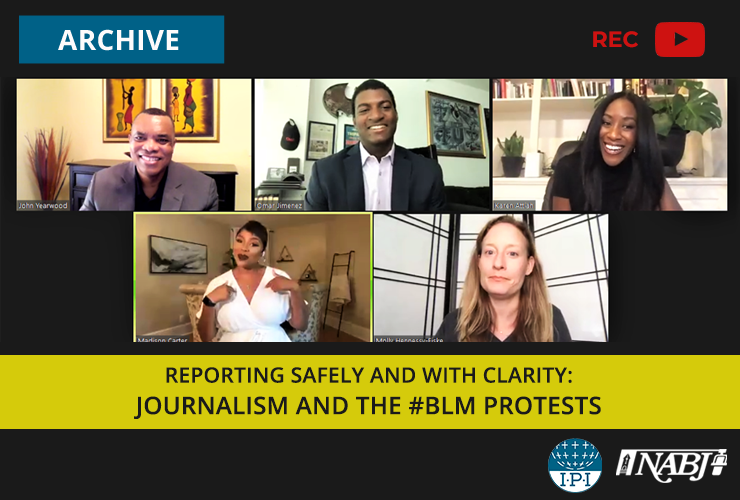Following the murder of George Floyd and the ensuing nationwide protest against institutionalized racism, American journalist have been called to witness a turning point in the country’s history.
Speaking in an online discussion organized jointly by the International Press Institute (IPI) and the National Association of Black Journalists (NABJ), four prominent U.S. journalists, editors and reporters – Karen Attiah, global opinions editor of The Washington Post; Madison Carter, a reporter with the WKBW-TV 7 Eyewitness News in Buffalo, New York; Molly Hennessy-Fiske, Houston bureau chief for The Los Angeles Times, and CNN’s Omar Jimenez – analyzed the latest developments surrounding media coverage of Black Lives Matter. They not only addressed the current press freedom challenges and safety implications when covering the demonstrations, but also underscored the immense task that American journalism has to undertake to help communities understand and navigate this moment.
Missed the event? Watch the video recording
At the beginning of the discussion, the speakers offered insights into their experiences of covering Black Lives Matter protests. Hennessy-Fiske was sent to Minneapolis very early on, together with staff photographer Carolyn Cole, to cover protests at a police precinct. There, the Minnesota State Patrol used pepper spray, tear gas and rubber bullets against a group of reporters, even though it was obvious that they were journalists.
“I got hit in the leg with what I believe was a rubber bullet, and Carolyn was sprayed in the face with pepper spray”, Hennessy- Fiske said, sharing her traumatic experience as a frontline journalist covering the story. We had to flee and take cover and eventually seek treatment. I have reported from a lot of countries – Egypt, Mexico – that are known to have police crackdowns not just on the people but also on journalists. But based on normal rules of engagement when I had reported in other parts of the U.S., in other protests, I was not chased, I was not shot at with rubber bullets or directly targeted. Obviously, things have changed.”
Omar Jimenez, a correspondent for CNN, whose arrest while reporting on the protests caused a huge outcry in the U.S. and around the world, also shared his first- hand experience. “We had been right outside the 3rd precinct. In a matter of minutes. law enforcement swarmed, cleared everyone. The police had created a line and we were outside that line. Next thing we know, my crew and I are surrounded. I am continuing, trying to report, and the next thing I hear from the Minnesota State Patrol is “you are under arrest”. They took me away. My photographer Leonel Mendez kept the camera rolling as long as he possibly could. We were in custody for about an hour and a half, in cuffs the entire time.”
The Washington Post’s Karen Attiah said that the perception that the U.S. had been a safe place to work, and that the attacks were something new, was not entirely correct. “It has always been dangerous to report on white supremacy and racial inequality”, she noted.
She also highlighted online attacks on journalists. On the question of whether the challenges faced by female journalists are different to challenges faced by their male colleagues, Attiah stated that studies show that black women receive more online abuse than white women, or black or white men.
Furthermore, panel members analyzed the high number of press freedom violations that have taken place in the U.S. during the Black Lives Matter protests and offered an insight into how to reverse and stop these violations.
“In this country, the only or the most powerful weapon that we have as journalists is the work that we do. However, it comes down to the people in power who have to respect the craft that we do”, Jimenez said. “As far as trying to remedy the challenges of press freedom, it comes down to infrastructures of organizations supporting their reporters, under any circumstances, and challenges to their freedoms. It comes down to solidarity amongst reporters themselves. We, our organizations and our voices, hold a lot of power, because in a lot of cases we are bringing things out there that the people in power don’t want to be seen.”
Madison Carter, who is also the president of NABJ’s Buffalo chapter, said that black journalists had been hired as props for decades and that newsrooms were unprepared for the situation
“I was the only black reporter out of all the TV stations in Buffalo on the first day of the protests, in a city that is 40 percent black”, she recounted. “I looked back and the story and could see the context was missing.”
Addressing the question of what impact the recent incidents had globally, Jimenez emphasized that the U.S. is looked up to in many aspects, including press freedom, and expressed his worry that it may give other countries an excuse may push things even further when it comes to the way they treat journalists.
Reflecting on the arrest incident, Jimenez also sent a message of strength in his remarks.
“Despite what happened to us, we went right back out there. What we bring to the table is more powerful than what you are trying to take away from us.” We wanted to send the message: ‘What they did won’t get in our head and won’t stop us.’”
